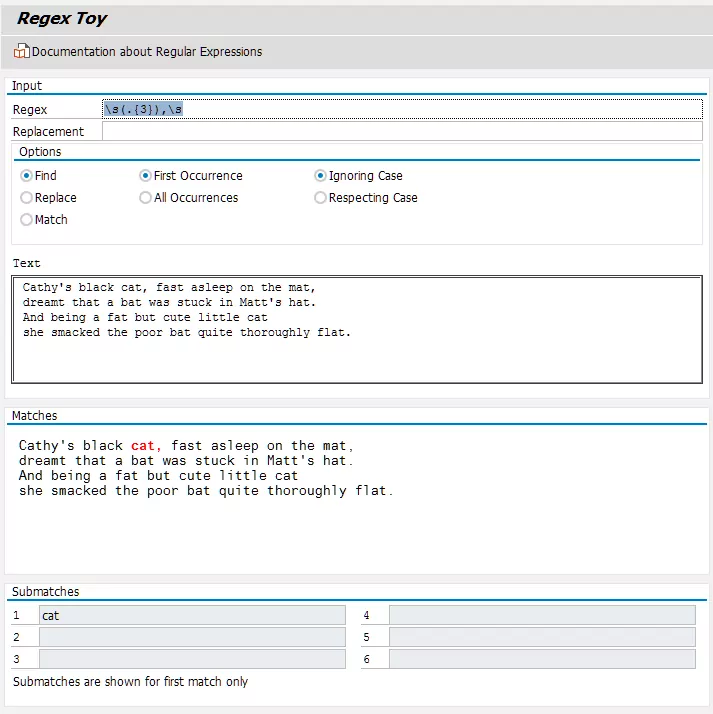Using Regular Expressions in ABAP
Comprehensive guide to using regular expressions in ABAP, featuring practical examples, validation techniques, extraction methods, and tips for leveraging CL_ABAP_REGEX and CL_ABAP_MATCHER for efficient string manipulation in SAP environments.
Regular expressions (regex) are a powerful tool used to search, match, and manipulate strings in programming. They are widely used for tasks like validation, parsing, and transformation of text data. In ABAP, regular expressions are supported natively for certain string operations, making it easier to work with complex text patterns.
🔍 Regular Expressions in ABAP
In ABAP, regular expressions can be utilized with the FIND and REPLACE statements. These operations allow you to search for patterns and manipulate strings based on those patterns.
Example of FIND:
The FIND statement can be used to search for occurrences of a regular expression in a string:
1
2
3
FIND ALL OCCURRENCES OF REGEX lv_regexp
IN lv_field
SUBMATCHES lv_sub1 lv_sub2.
Here:
-
lv_regexpis the regular expression pattern you’re searching for. -
lv_fieldis the string in which you’re searching. -
SUBMATCHESallow you to capture portions of the match, storing them inlv_sub1andlv_sub2.
Example of REPLACE:
The REPLACE statement is used to replace occurrences of a regular expression in a string:
1
2
3
REPLACE ALL OCCURRENCES OF REGEX lv_regexp
IN lv_input
WITH lv_replacement.
In this case:
-
lv_regexpis the regular expression you’re looking to match. -
lv_inputis the string where the replacements will take place. -
lv_replacementis the text that will replace the matched occurrences.
🆕 ABAP 6.40 and Later: CL_ABAP_REGEX and CL_ABAP_MATCHER
Starting from ABAP 6.40, SAP introduced the classes CL_ABAP_REGEX and CL_ABAP_MATCHER, which provide more advanced functionality for working with regular expressions. These classes offer an object-oriented approach to regex handling, similar to what you might see in Java, making regular expression handling in ABAP more powerful and flexible.
Here’s an example of how you can use these classes:
1
2
3
4
5
6
7
8
9
10
11
12
13
14
15
16
17
18
19
DATA: lv_value TYPE string VALUE '1234567890'.
DATA: lo_regexp TYPE REF TO cl_abap_regex,
lo_matcher TYPE REF TO cl_abap_matcher.
CREATE OBJECT lo_regexp
EXPORTING
pattern = '[A-Z]' " Regex pattern to match uppercase letters
ignore_case = abap_true. " Case-insensitive matching
lo_matcher = lo_regexp->create_matcher( text = lv_value ).
IF lo_matcher->match( ) EQ abap_true.
WRITE:/ 'It's a match'.
ELSE.
WRITE:/ 'Not a match'.
ENDIF.
Key Points:
-
CL_ABAP_REGEX: This class represents a regular expression object. You define the pattern and any flags (like case sensitivity) here. -
CL_ABAP_MATCHER: This class is used to perform matching operations. After creating a matcher object using thecreate_matchermethod, you can check whether the string matches the regex pattern using thematchmethod.
In this example, the regular expression "[A-Z]" is used to search for uppercase letters in the string '1234567890'. Since there are no uppercase letters, the output would be 'Not a match'.
🔑 Key Concepts of Regular Expressions
Here are a few core concepts and examples of regular expressions you can use in ABAP:
-
Character classes:
-
[A-Za-z]– Matches any uppercase or lowercase letter. -
\d– Matches any digit (equivalent to[0-9]). -
\w– Matches any word character (letters, digits, and underscores). -
\s– Matches any whitespace character (spaces, tabs, etc.).
-
-
Quantifiers:
-
*– Matches 0 or more occurrences of the preceding element. -
+– Matches 1 or more occurrences of the preceding element. -
{n}– Matches exactlynoccurrences of the preceding element. -
{n,}– Matchesnor more occurrences of the preceding element. -
{n,m}– Matches betweennandmoccurrences of the preceding element.
-
-
Anchors:
-
^– Anchors the match to the start of the string. -
$– Anchors the match to the end of the string.
-
-
Grouping and Alternation:
-
()– Groups expressions together to apply quantifiers or to capture parts of the match. -
|– Acts as an OR operator. For example,(abc|def)will match eitherabcordef.
-
🧪 Testing Regular Expressions in ABAP
Testing regular expressions in ABAP is simple and can be done using SAP’s built-in demo program DEMO_REGEX_TOY. This program provides an interactive way to test various regex patterns and see the results directly within the ABAP environment.
The demo program allows you to experiment with different regex patterns and see how they match against sample data. It’s a great tool for learning and testing regular expressions before implementing them in your own ABAP code.
🛠 Practical Use Cases for Regular Expressions in ABAP
-
Validating Input: You can use regular expressions to validate user input, such as ensuring an email address or phone number matches a specific format.
1 2 3 4 5 6 7 8 9 10 11 12 13 14 15 16
DATA: lv_email TYPE string VALUE 'test@example.com', lo_regexp TYPE REF TO cl_abap_regex, lo_matcher TYPE REF TO cl_abap_matcher. CREATE OBJECT lo_regexp EXPORTING pattern = '^[A-Za-z0-9._%+-]+@[A-Za-z0-9.-]+\.[A-Za-z]{2,}$' " Email regex ignore_case = abap_true. lo_matcher = lo_regexp->create_matcher( text = lv_email ). IF lo_matcher->match( ) EQ abap_true. WRITE:/ 'Valid email address'. ELSE. WRITE:/ 'Invalid email address'. ENDIF.
Extracting Information: You can use regular expressions to extract certain pieces of information from a string, such as extracting phone numbers from text or finding specific patterns in log files.
Replacing Patterns: Regular expressions can be useful for cleaning up or transforming data, such as replacing all occurrences of a certain pattern (e.g., replacing all spaces with underscores or formatting phone numbers).
🆕 2025 — Practical patterns, modern examples and quick tips
Here are some small, practical examples and tips collected from recent projects to make regex work in ABAP more reliable and maintainable.
1) Extract email local part and domain
1
2
3
4
5
6
7
8
9
DATA(lv_email) = 'user.name+tag@example.co.uk'.
DATA(lv_user) TYPE string.
DATA(lv_domain) TYPE string.
FIND REGEX '^([^@]+)@(.+)$' IN lv_email SUBMATCHES lv_user lv_domain.
IF sy-subrc = 0.
" lv_user = 'user.name+tag', lv_domain = 'example.co.uk'
WRITE: / 'user =', lv_user, 'domain =', lv_domain.
ENDIF.
2) Strip HTML tags (quick sanitise)
1
2
3
DATA(lv_html) = '<p>Hello <b>world</b></p>'.
REPLACE ALL OCCURRENCES OF REGEX '<[^>]+>' IN lv_html WITH ''.
" lv_html now 'Hello world'
3) Mask a credit-card like string (use backreferences in replacement)
1
2
3
DATA(lv_cc) = '4111222233334444'.
REPLACE ALL OCCURRENCES OF REGEX '(\d{4})\d{8}(\d{4})' IN lv_cc WITH '\1********\2'.
" lv_cc becomes '4111********4444'
4) Find multiple occurrences and inspect submatches
The procedural FIND ALL OCCURRENCES OF REGEX or FIND with SUBMATCHES is often enough. For more advanced control (iteration, retrieving offsets), you can use CL_ABAP_REGEX/CL_ABAP_MATCHER together with find/match methods — but prefer the simple statements for readability and maintainability when possible.
5) Testing and tooling
- Use SAP’s
DEMO_REGEX_TOYto experiment interactively inside your system. - When developing patterns, test them on an external regex tester (regex101.com) using the PCRE flavor — it helps to check capture groups and replacements. ABAP’s flavor is close to PCRE for most common constructs, but always verify with
DEMO_REGEX_TOYor small ABAP snippets.
6) Performance and safety
- Avoid overly broad
.*patterns when you can use more specific character classes; greedy patterns can cause performance issues on long strings. - Escape regex-special characters (dot, plus, parentheses, etc.) as needed. In ABAP string literals, backslashes are literal, so write
\dand\sdirectly (you do not need to double-escape the backslash itself). Be mindful when embedding ABAP in other contexts or editors that may change escaping rules. - Prefer
REPLACEandFINDstatements for simple operations — they’re concise and clear to other ABAP developers.
🧠 Final Thoughts
Regular expressions in ABAP are a powerful tool for string manipulation, validation, and extraction. With the introduction of classes like CL_ABAP_REGEX and CL_ABAP_MATCHER in ABAP 6.40, working with regular expressions in ABAP is now easier and more flexible than ever before. Whether you’re validating input, extracting data, or performing replacements, regular expressions can help you handle complex string operations with ease.
By leveraging built-in tools like the DEMO_REGEX_TOY program and understanding the core concepts of regular expressions, you can improve your ABAP coding skills and handle text-based tasks more efficiently.

